30 October 2023
![]() 21 mins Read
21 mins Read
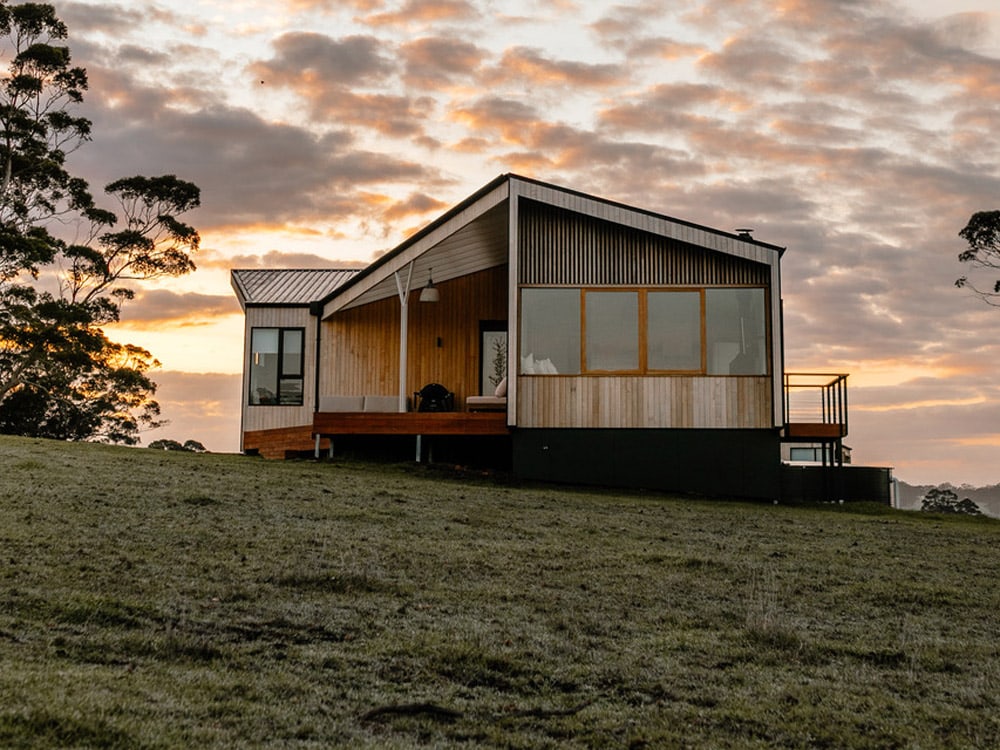
Here are the eight boutique stays that made it into positions 66 to 74 of our coveted list of 100 unique stays. Head here to read the full list and start planning your next escape.
Drive into the hills of the Byron Hinterland, along country roads sprinkled with seasonal fruit stalls, and wonder for a moment where exactly you’re going. Then pull up to the old Eltham Hotel, elegant with its Queenslander facade. “You’ve already taken a breath of fresh air and then by the time you get there, you’re greeted with great music, a big smile and a cold drink,” says Julia Ashwood. You’ve arrived.
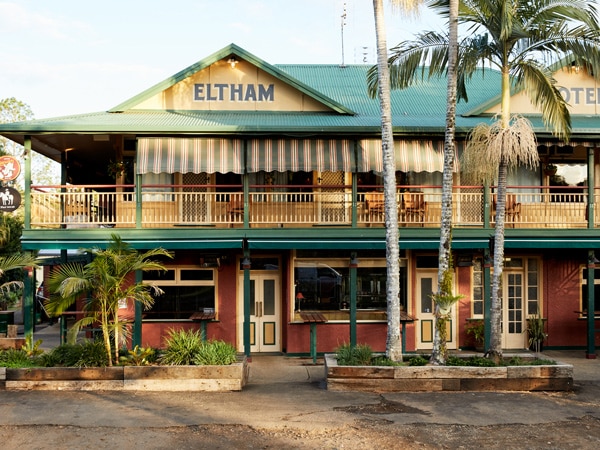
Stay at the Northern Rivers iconic Eltham Hotel. (Image: Jessie Prince)
Two years ago, Julia, founder of The Vista, bought this historic pub with husband Matt Rabbidge and business partner Luke Sullivan. It was built in 1902, when the tiny town of Eltham was a thriving railway village, and has been a community hub ever since. The trio’s approach to its restoration was “consciously gentle”, says Julia. “We never wanted to change it by any means. It’s beautiful as it is.” But they’ve imbued it with a creative spirit that permeates everything from a roster of live music, teamed with the spontaneous energy of the Eltham House Band, to a menu that supports local by chef Tim Goegan (ex Supernormal). Serving classic with a twist, you’ll find foodie numbers like burrata with freshly baked focaccia and staples like schnitzel and steak, plus great vegan and kids’ options, rounded off by an impressive wine list.
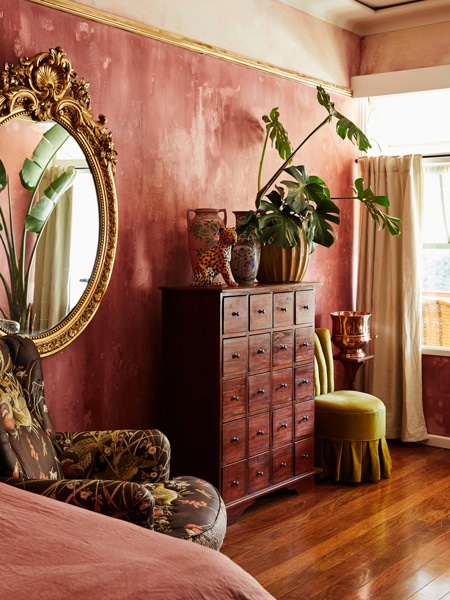
Beautiful details at the Eltham Hotel. (Image: Jessie Prince)
The cherries on top of the experience are the five bedrooms upstairs, which Julia has transformed into boutique accommodation with bags of originality. Looking for a refreshing but interesting way to refurbish the rooms, an idea crystallised after talking to the regulars and hearing the same tales of local women crop up again and again. “So then these five stories developed with these five great, albeit quite kooky, women,” says Julia. “Overnight, I knew exactly what I was doing in each room and exactly what sort of colours they needed for their walls. What rug they’d have on the floor, what lighting they’d appreciate, what music they listened to.” After a “Marketplace, Gumtree and car boot sale siege”, it all came together with a little bit of alchemy: five distinct bedrooms all rendered with their own personalities.
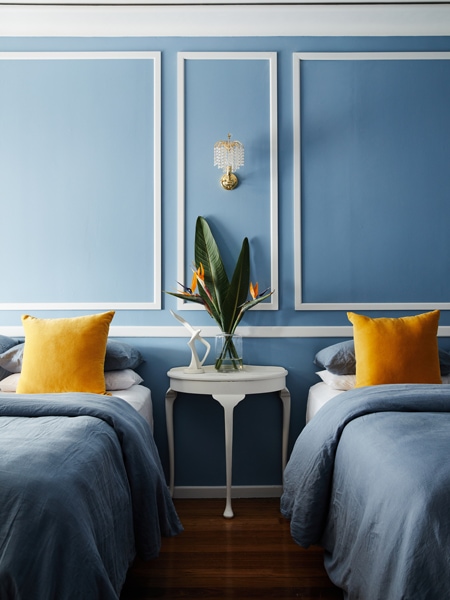
Stay near the Byron Hinterlands at Eltham Hotel. (Image: Jessie Prince)
There’s the Margaret, for the former station master at Eltham: all colours of the Australian earth and hints at tobacco, leather and steel. The Rhonda, decadent in shades of port wine magnolia, is dedicated to a sex worker who lived at the Eltham in the ’70s. Cool, classy and a little Art Deco, The Delilah is an ode to a showgirl from Lismore while the botanical-inspired Estelle is a nod to Matt’s mother, an avid gardener. The pretty Patsy, its walls a soft pink blush decorated with a rose and bird mural, is for Julia’s own mum: a local Lismore girl. “Through the years and years before me, my family used to [go to the Eltham]. And she tells me stories of what used to go on there.” The result is something that’s completely of its place and community. “There’s so much beauty in history,” says Julia. “What I was trying to do is just dive deeper into that and bring out the stories.”
The bass strait shimmers silver as we follow the coast road west of Burnie. Silhouetted dramatically against the sky in the fading light of the day, we soon see it. The Nut dominates the landscape for miles around: the remains of an ancient volcanic plug that, standing sentinel above Stanley, shows us where we’re heading. Our home for the next two nights is tucked right at its base. It wasn’t quite on the way from Sydney to Hobart, but then the Ship Inn Stanley is the kind of place you can reasonably detour halfway across the state for. An old sailors’ tavern reimagined as a storytelling inn, in a historic town on the wild and rugged North West coast of Tasmania, it had captured my imagination since it opened in 2019. And it doesn’t disappoint. This artfully luxurious renovation of a drinking establishment dripping in history has been brought to life in such an authentic way that you’d half expect a drunken sailor to stumble through the door in search of revelry. Well, in the Bayview Suite at least.
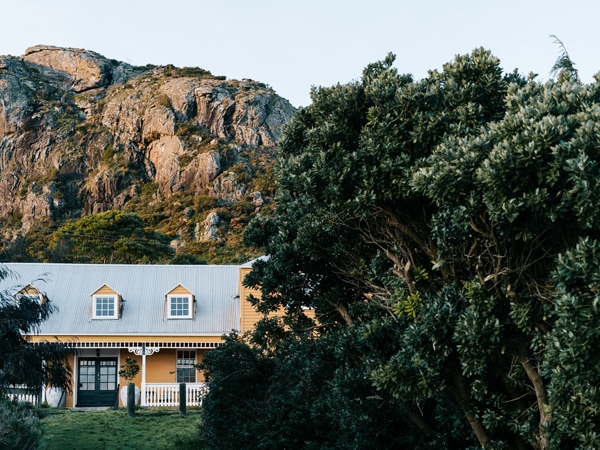
The lovely and modest Ship Inn. (Image: Marnie Hawson)
Tucked in the weatherboard wing of the mustard-yellow two-storey building, our quarters once served as the pub’s old cabaret room. A welcoming plaque speaks of ‘barbarous syncopated rhythms’ that once blared from the gramophone. If only these floorboards could talk. Built in 1849 by a prime minister’s grandfather and the closest pub to the bustling port, the Ship Inn started life as The Shamrock Inn. In the years that followed until it closed its doors in 1972 (falling into disrepair before becoming a private home), it saw a long list of licensees come and go and a melting pot of humanity congregate within its walls. When current owners Kerry and Alastair Houston embarked on their new project to resurrect it as a boutique guesthouse, uprooting from Hobart, they reinstated one of its earliest names. “We soon uncovered so much history about the building and the region that we had to tell the stories,” Kerry told Australian Traveller in 2020.
The suite my partner and I check into pays homage to the inn’s time trading as the Bayview Hotel. With views across the port, it is elegantly styled and embellished with historical artefacts. The moody tone of green on the walls is the colour of the sky before a thunderstorm and reflects the weather outside as the clouds close in. Cocooned in rich linens with sumptuous feather and down pillows, I’m grateful I’m warm and cosy and not out there on the seas as the rain comes down overnight; up the century-old timber staircase from here, the Wild Wave suite is dedicated to the memory of its namesake tall ship, which met its fate on tumultuous waters in 1923, coming to rest on Tatlows Beach.

Ship Inn bedroom details. (Image: Marnie Hawson)
Across the front verandah from us, the space that was once the bustling bar of the 1800s pub is now a superbly styled two-bedroom apartment that speaks of the seafaring adventures of Roaring Tom, while next door to that is Stanley’s original billiards halls and now The Ghost of Old John Peacock guest lounge, with leather armchairs we’d sunk into earlier that evening over Tassie wine and cheese sourced from the cottage store down the road.
Lyons Retreat tells the tale of Joseph Lyons, Australia’s first Tasmanian-born prime minister who was born in the weatherboard settler’s cottage next door that operates today as a house museum. And Highfield serves a contemporary twist on British culture in a nod to Highfield House and the English gentry who sought to emulate home on an unyielding landscape. This Regency-period homestead perched on a wind-blown promontory overlooking The Nut just out of town was built by convict labour for Edward Curr, chief agent of Van Diemen’s Land Company, and marked the first European occupation in North West Tasmania. Today you can walk the rooms and corridors of this historic site, look out of the yawning French windows with dramatic views over the rugged coastline and learn about the people who lived here. Although the company purported to be committed to the protection of the Tommeginne people, this was not a reality, and the site doesn’t shy away from reflecting on the atrocities that were inflicted on the area’s Traditional Owners, including the 1828 Cape Grim massacre.
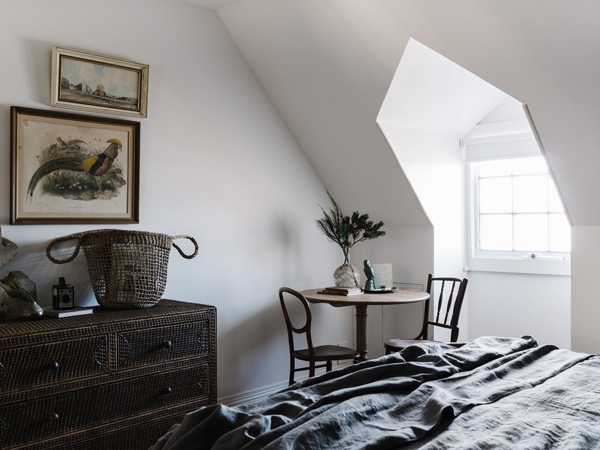
Wake up to the stunning Tasmanian landscape. (Image: Marnie Hawson)
The Ship Inn’s Moo-Nut-Re-Ker suite celebrates the wild beauty of The Nut and is a nod to its palawa name. In the morning the clouds have cleared and the bay below is still. We unwrap our fresh sourdough loaf from the inn’s customised paper and eat it with the provisions left for us: simple but delicious Tasmanian jams, yoghurt, granola and fruit compote. And then there’s nothing else to do than climb The Nut that towers above us. I had expected the goat-track-steep hike to the top (the rather nifty chairlift is closed in the winter) and the world’s-end views out to Bass Strait, but I didn’t expect to find a glorious buttongrass wilderness. Interpretation boards at the first lookout we come to speak of conflict and dispossession of the palawa, the scars on the land around us, but also of the site’s ongoing importance and continuing cultural practices surrounding the moonbirds that proliferate up here. A potoroo ambles across my path and a wallaby rustles in the bush. It’s alive with stories up here as well.
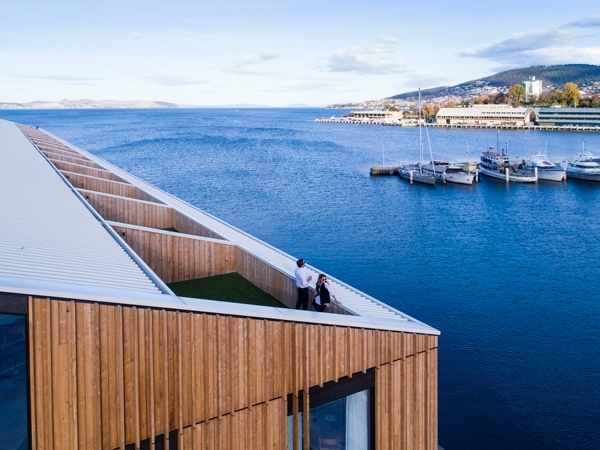
Hobart’s MACq 01 Hotel. (Image: Stu Gibson)
As Australia’s first storytelling hotel, the five-star MACq 01 Hotel was designed to bring Tasmania’s fascinating stories to life. Based on Hobart’s historic Macquarie Wharf, which in previous lives has been a bustling wharf market and later a giant shipping shed, the hotel has 114 rooms matched with 114 unique character tales that give visitors insight into the island state’s storied past: convicts, sailors, beekeepers and Indigenous trailblazers among them. – Imogen Eveson
From the iconic harbour to alternative inner-city neighbourhoods, Sydney is a city of many faces. And for me, one of its best angles is the tranquil, bush-fringed waterway of Pittwater. Somewhere like Great Mackerel Beach, a stone’s throw from glamorous Palm Beach but another world entirely. This peaceful hamlet is accessible only via a bushwalk through Ku-ring-Gai Chase National Park or a ferry ride across from Palm Beach: a crescent moon of sand dotted with holiday homes made for the laziest of days, and a superstar Airbnb among its ranks called The Little Black Shack.
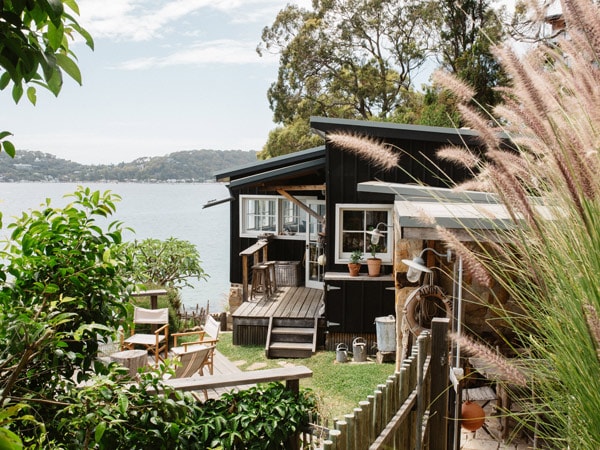
The Little Black Shack exterior. (Image: Luisa Brimble)
This old shack hand-built by fishermen around the 1930s has been fashioned into a stylish eco retreat that exudes character and authenticity. It has tales to tell and a commitment to sustainability that starts with recycled building materials and plenty of upcycling. The shack is full to the brim with an eclectic mix of pre-loved furniture, collectables and objects gathered from its owners’ travels and beach forages. Even the timber that makes up the base of the main bedroom’s comfortable king bed, lined with organic linens, had a previous life as a ramp to transport materials from the beach to the site. Everything here tells a story and it all amounts to a unique experience. And with so much thought stitched into every seam, all that’s left for you to do is feel inspired to enjoy life’s simple pleasures: from full moons and sunrises to open fires to reading books in a hammock and beachcombing for your own treasures. – Imogen Eveson
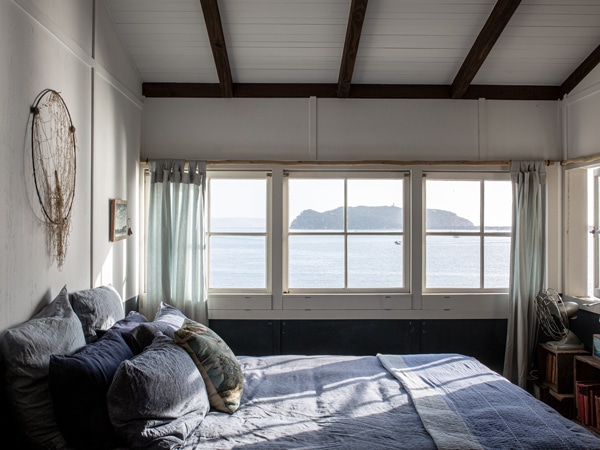
You can’t escape ocean views at The Little Black Shack. (Image: Luisa Brimble)
You’ll find garig gunak Barlu National Park at the very top of the Northern Territory: a pristine and rugged natural environment fringed with magnificent white beaches. Part of Arnhem Land’s Cobourg Peninsula, which stretches long into Arafura Sea, it might not be the first place you’d expect to find an oasis of boutique luxury. But here you have it, an iconic wilderness lodge which, when it opened in 1990, was one of the first luxury lodges in the outback.
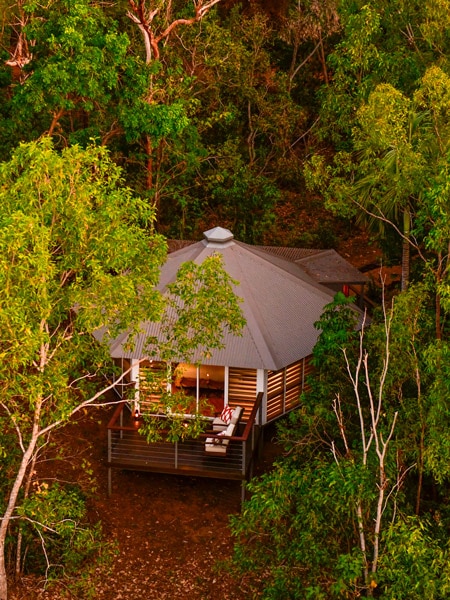
Seven Spirit hut. (Image: Steve Strike)
True to its remote location, it’s only accessible by boat or by aircraft that flies into what’s cheekily named Seven Spirit Bay International Airport; you could be forgiven for wondering if you’ve accidentally skipped the country – any further north and you’re in Indonesia. But with the tropical air fragrant with eucalyptus and the chorus of the Aussie bush all around, there’s no mistaking where you are, however far removed from everyday life this exotic hideaway feels. Seven Spirit Bay was acquired and renovated by Outback Spirit in 2015, its original ‘habitats’ transformed into 24 luxurious villas, each with an en suite and private balcony.
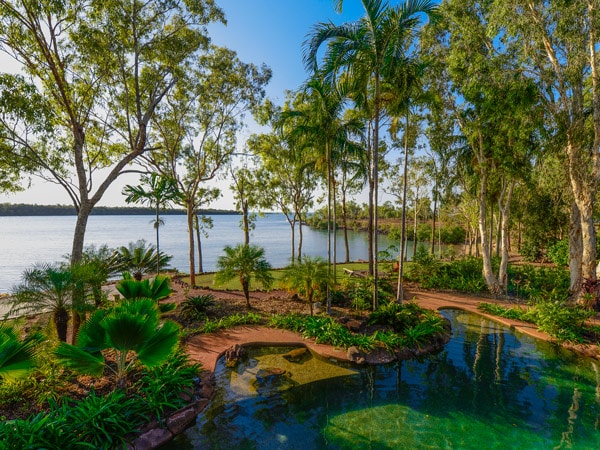
The tropical grounds of Seven Spirit Bay. (Image: Steve Strike)
Days here are spent out and about on marine adventures, 4WD wilderness safaris, fishing expeditions and bush tucker tours. Or simply cooling off in the palm-fringed lagoon pool and fine dining on the catch of the day with views over the turquoise Coral Bay. Sunsets here are of the #nofilter variety, of course.
When is a dairy shed not a dairy shed? When it is a luxe farmhouse stay packed with interestingly quirky features. Here, we explore The Silo House with its owner Belinda Scott.
The site was the location of my husband Allister’s family’s original farmhouse that burnt down when a share farmer was living in it four years ago. It backs onto the family dairy farm and, as three generations have lived on the farm, it has great sentimental value to everyone in the family. When deciding what to rebuild, Allister and I thought we should pay homage to the farming history, and our aim was for anyone driving past to think it was a dairy shed, not a residence. We had a lot of fun with it, trying to stay true to the farming shed look, but also creating amazing spaces of freedom and comfort.
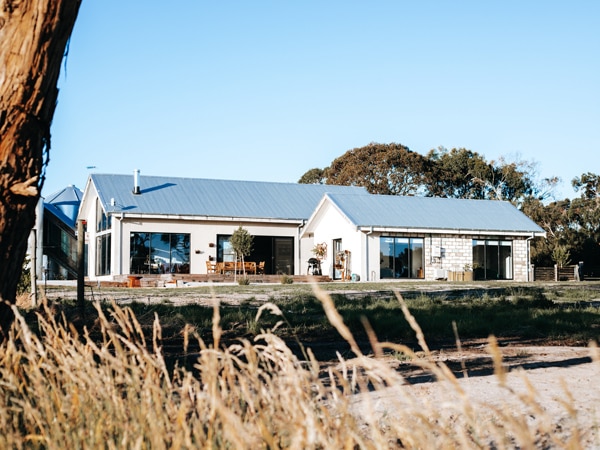
The Silo House Inverloch.
Make it look like an authentic dairy shed, but be very liveable, practical and exciting to explore.
Once inside, it has amazing spaces to gather, entertain, relax and escape the world in. There are also so many details in each room that you feel like you are constantly exploring, noticing and appreciating new things. The interiors are filled with some eclectic pieces, including old prison doors; what elements resonate with you? Definitely the history of the prison doors and the farming and agricultural touches such as the suspended cattle walkway on the second level. The view is pretty spectacular, too.
I describe myself as a bowerbird, collecting old treasure with a story to tell from all over. Many of our items came from local farmer David Wrench, of Outtrim, a big-time hoarder whom we visited regularly throughout the build to find either pieces that would fit the build or pieces that we made fit the build.
That it is so much more than a place to stay. It is an experience, an escape. Whether it’s sleeping in a round silo bedroom with a view across the farm and vineyard [which Allister planted with pinot noir vines], showering in a unique water-trough shower, or hiding away in the underground milking pit turned gin bar lounge [viewed through a glass panel in the floor of the living area], there is so much to do within the premises.
That they didn’t leave the house during their stay or want to leave after their week because they hadn’t had enough time to explore and enjoy everything.

The rustic interior of Silo House.
One of the first things I learn about Warders Hotel, after I step into a haven of thick limestone walls and original wooden boards, is that ghosts may lurk here. “We had a ghost buster come through,” says the welcoming staff member. “A lot of people say they see them.” It makes sense. Built in 1851, the terrace houses were home to the warders of nearby Fremantle Prison – oodles of potential for disgruntled ghouls. Yet the space has the feel of a peaceful sanctuary, proof of an elegant transformation into a boutique hotel, which opened late 2020.
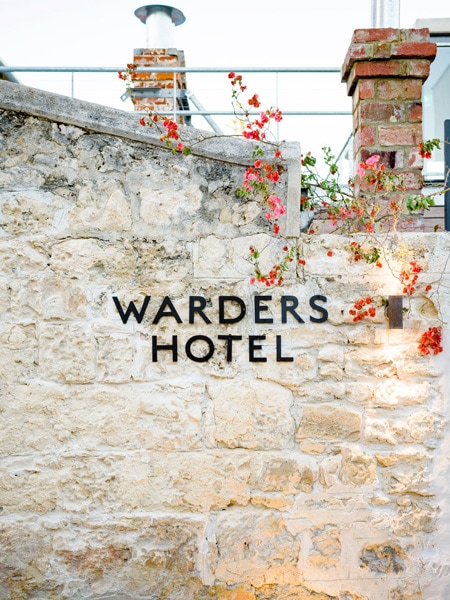
The beautiful architecture of Warders Hotel.
My room, 23U, is one of just 11. My door opens to a little sign proclaiming, “All the contents of this bar fridge are complimentary”. Happy days. I continue past a spacious, marble-clad en suite, walking over restored timber boards that gently creak a reminder of the history underfoot. In the bedroom, calming blue accents meet tightly tucked white linen, a high ceiling and white walls traced with copper piping – an artful retrofit hiding electricity cords that ensure ample illumination.
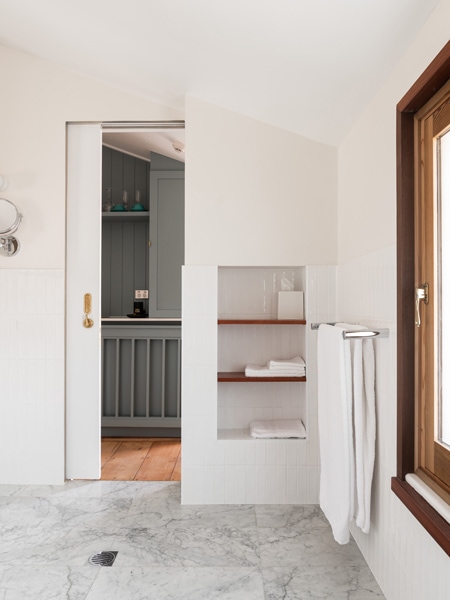
The little details win me over. Still and sparkling water taps crafted from aged brass, fresh lime and lemon and a QR code on the wall allowing me to order room service via my smartphone. Dinner – lobster and truffle dumplings; smoky beef hofun noodles – arrives furnace-hot from the hotel’s adjoining restaurant, Emily Taylor. It’s named after a spice trading ship that came to grief off Fremantle in 1830. I feast propped with pillows, glass of malbec in hand, hit go on a romantic movie and settle in. It’s Cheshire-cat-level glorious.
I wake in the night and do a room scan: no ghosts. I’m disappointed. Well, almost disappointed. Complimentary breakfast is held in the venue’s bijou bar, Gimlet; excellent coffee and a crisp Portuguese tart both rise above expectations. I depart reluctantly, engulfed by the aromas and energy of the neighbouring Fremantle Markets, literally about 10 steps away.
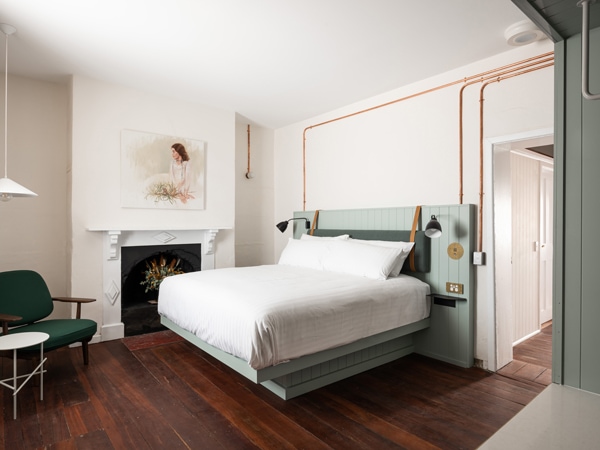
Warders Hotel bedroom (image: Dion Robeson).
The port of Fremantle, on the fringes of Perth, is on the up and up. Freo, as it’s affectionately known, is equally scruffy and smart and the gateway to one of WA’s coolest street scenes. The working port is located at the mouth of the Swan River and it’s where you will still find legit lobster boats pulling into the boatyards, one of which has become Little Creatures brewery and a prime perch for a pale ale. In addition to those endless ocean views, Freo (Walyalup) has less in-your-face charms such as its Indigenous history, walls of street art, and food and drink scene that nods to the diversity of cultures here. While the low-key port had previously attracted a boho-cool crowd, it’s now a place to go for everyone from families to couples drawn to the bakeries, bars, brewpubs and boutique shopping. – Fleur Bainger
The idea of luxury in Longreach hits different. For travellers like myself, who are drawn to the red dirt and yawning spaces of the Queensland outback, Saltbush Retreat makes an ideal basecamp that is rustic and elegant in equal measure.

The beautiful timber exterior of Saltbush.
The idea behind the low-lying dwellings was to house guests in style while blending into the landscape and the accommodation does just that. I’d go so far as to say they’ve nailed it, but ironmongery was scarce in colonial Australia. The property is dotted with the 4.5-star Homestead Stables, cosy four-star Slab Huts and Outback Cabins that would have pleased the very poshest of pioneers. After an afternoon spent tearing around the countryside on a Cobb & Co. stagecoach experience, dusting my boots off and settling into my homey hut was a dream. The slab huts, which were crafted out of red gum using traditional outback building techniques, are surrounded by the saltbush the retreat is named after. In the outback, where the sky goes on forever, the sunrises are spectacular so I rose at dawn to stroll along the interpretative native flora walk past waterholes and tufts of saltbush, bristling out of the earth like whiskers on a chin.
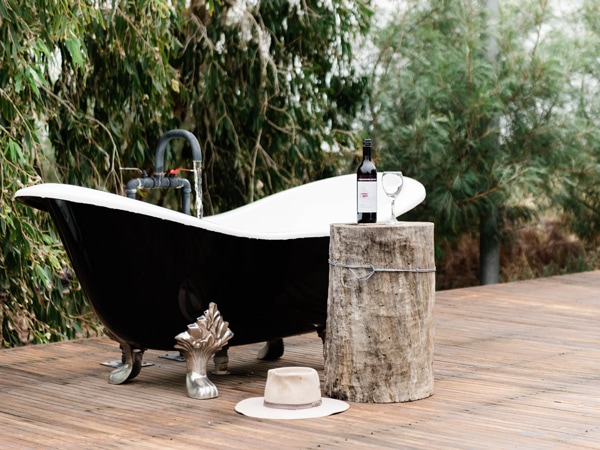
Relax with an outdoor bath and wine at Saltbush.
The outback retreat’s proximity to some of Longreach’s major attractions is definitely a draw: it was an easy walk across the way to the Qantas Founders Museum and through a knot of trees to the Australian Stockman’s Hall of Fame. And while the idea behind the slab huts is to offer guests an old-world charm, I really wanted for nothing when it came to the mod cons. Antiques happily share the room with state-of-the-art espresso machines and premium Appelles amenities and the four-poster bed, barn-style doors and complimentary wi-fi become welcome bedfellows. Outfitted with covered porches and decked out in tasteful hand-crafted furniture, Saltbush Retreat inspires the kind of ‘g’day mate’ conviviality that is the currency in country Australia. During my stay, guests who were not eating out in town took advantage of the barbecue facilities and we shared a bottle of Shaw & Smith wine and platter of Barossa Valley Cheese purchased from reception. My day at Saltbush Retreat ended in a hot bath on the outdoor terrace watching shooting stars streak across a velvety night sky, elevating the outback experience even further. – Carla Grossetti
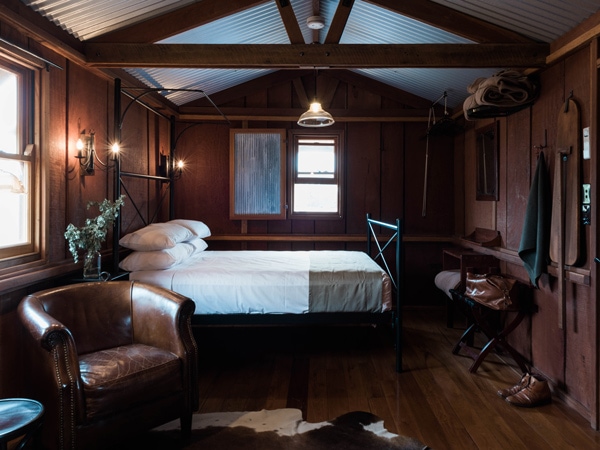
Saltbush’s cosy bedroom.
Think of it like a bijou farm stay: the chance to hole up in a gorgeous two-bedroom guesthouse on your own private sanctuary on 43 hectares of cattle farmland. This architecturally designed stay at Upland Farm is located on the outskirts of the coastal town of Denmark in WA’s Great Southern region. It was built, along with the family home, by Tyrone and Shelley Kennedy of Alcove Engineering and Construction who were seeking something of a getaway themselves: the chance to live an uncomplicated lifestyle away from the city; to enjoy simple pleasures in a rural setting. Clad in Victorian ash and under the watch of towering karri trees, the guesthouse gives the impression of a cosy cabin, but once inside the light organic materials and a calming neutral palette of timber, mossy green and cream betray your proximity not only to farmland and vineyard but also rugged coastline.

Upland is situated on a beautiful farm property. (Image: Rachel Claire @fieldnotes__)
While here, you’re free to explore the property, but we’ll probably find you curled up with a glass of local wine in a cosy window seat soaking in the views. At night you can stoke the fire pit as you watch the sun set over rolling hills or cook up a storm in the kitchen. And there’s plenty to do on the doorstep besides. “Don’t forget to stop by Greens Pool and Elephant Rock for a morning dip, a walk along the Bibbulmun Track, followed by a visit to the local wineries with a packed picnic basket from our grazing menu,” suggests Shelley. “With wineries, famous walking trails and idyllic beaches just a short drive away, what more could you need to recharge?”
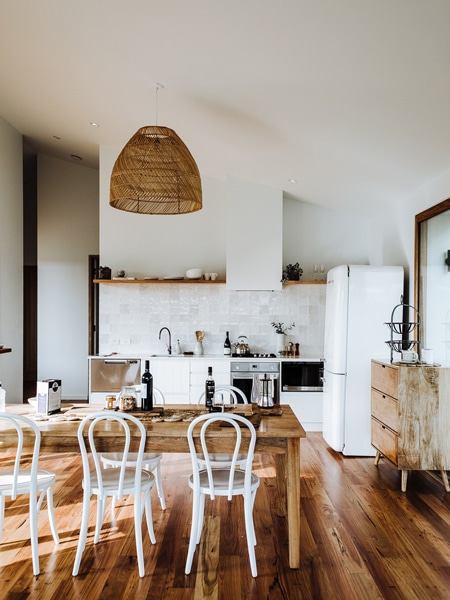
Upland’s modern farm inspired interior. (Image: Rachel Claire (@fieldnotes__)
Victoria’s old goldfields towns and cities possess an atmosphere all of their own – all the ambition and folly of 19th-century prospectors wrapped up in a wrought-iron balcony. And, in recent years, an injection of hot new establishments bringing fresh ambition and spirit to the streets, while staying true to a sense of heritage, has seen something of a cultural renaissance sweep through.
The Provincial Hotel Ballarat embodies this: a boutique hotel opened in late 2018 in an iconic building on historic Lydiard Street that is listed by the National Trust for its expressive Art Nouveau facade, domed turrets and all. Inside is a stylish and serene space that, in true Ballarat style, takes design cues from contemporary trends while staying sympathetic to the building’s old bones. Each room is uniquely curated and our Lola Deluxe room shares its namesake with exotic dancer and actress Lola Montez, who caused a sensation when she visited the Goldfields in the 1850s. The tribute extends to Lola restaurant downstairs, but instead of dancing on tables and drenching dukes in soup, here we’re dining in playfully sophisticated surrounds with a European- inspired menu shaped by the best of locally sourced produce. – Imogen Eveson

Enjoy a truly boutique experience at The Provincial (image: Marcel Aucar).
LEAVE YOUR COMMENT